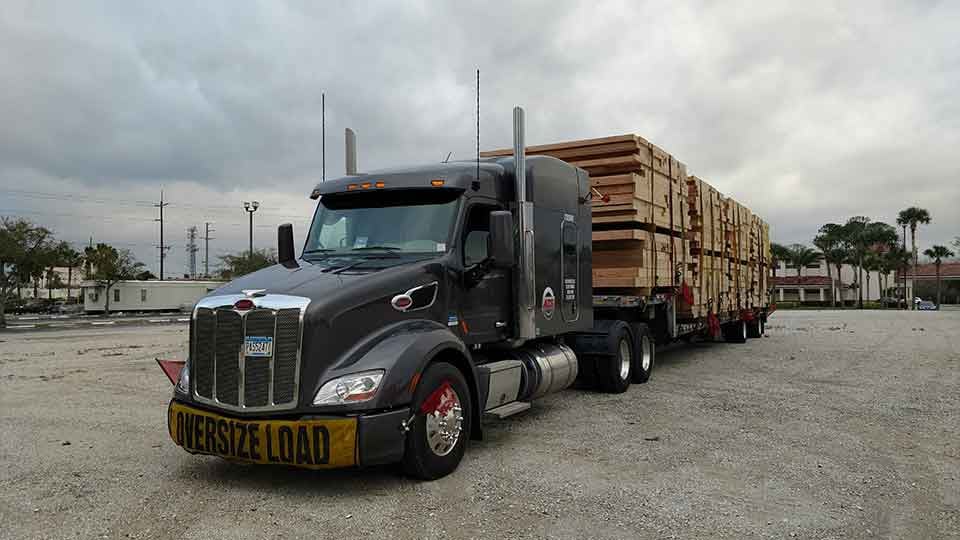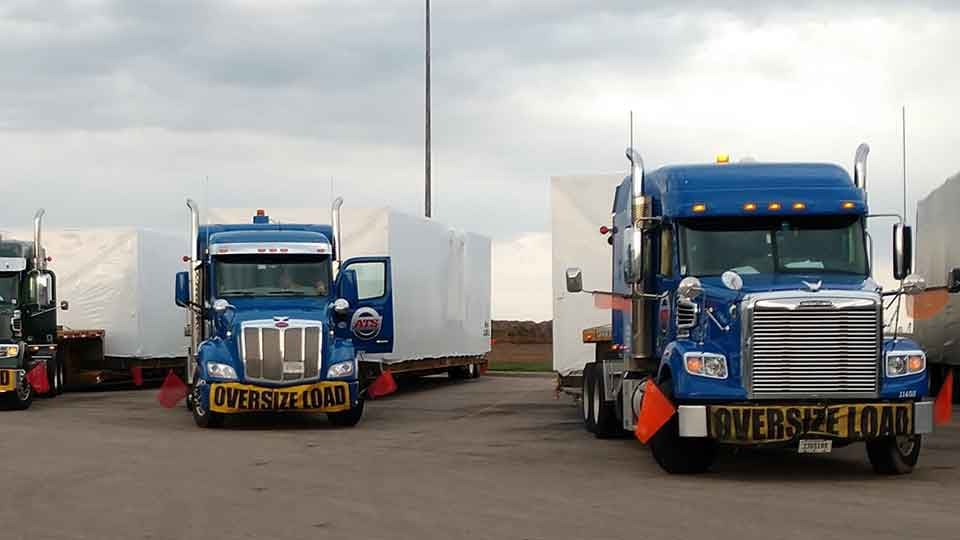In the transportation industry, size matters. If you’ve got flatbed freight that is 8 feet, 5 inches tall, it will drive safely under a bridge. And if that freight is 8 feet, 7 inches high, it requires a permit and a special route to avoid colliding with that bridge — potentially damaging the freight, the truck, the bridge and other vehicles, and possibly closing down a major road.
And it’s not just height that can ruin your day in the trucking industry. Hauling commodities even a short distance can mean driving through varying weather, over different road conditions, under dozens of bridges and powerlines, and through heavily-populated areas.
These variables mean it’s important that the driver (and the route planners) know exactly what will be on the vehicle, the exact dimensions and how that freight will react in different conditions.
At Anderson Trucking Service (ATS), we haul all types of commodities on a daily basis — including standard loads, over-dimensional freight and hazardous materials. Over 68 years, we’ve learned a lot about how to safely carry almost anything. One of the lessons has been the importance of a thorough, accurate specification.
In this article, you’ll learn why this precision matters, what information is needed about your commodity and how you can help the driver carry a safe load. This will help you work with a carrier to ship any material, anywhere in the country.
Why Being Specific About Your Cargo Matters
When requesting a quote from a carrier or broker, specify what will be shipped. A complete quote request will include the name of the item, a short description of the components, and all pertinent details. International shipments should also include the Harmonized System codes.
As obvious as it may seem that you need to name the commodity, these details are critical.
- How is the commodity packed? If you are shipping bulk material, the loading time will vary from palletized material. The driver needs to be able to plan for the required load/unload time onsite.

- How will it be loaded? Will you be using a loading dock or an overhead crane? This impacts the type of truck you need onsite.
- Can it be stacked? If freight must be configured in a certain way, that will impact the number of pallets that can fit in the vehicle.
No matter what you will be shipping, your broker or carrier needs detailed information. They are experts in moving it to the final destination. You are the expert in your commodity. Sharing the following details makes the strongest partnership:
Include Information About Potential Hazards
In addition to the name of the commodity, specify if hazardous materials, or materials with the potential to become hazardous, are on board. For example, if you are shipping a load of cell phones, note if they contain lithium batteries. Lithium batteries can become hazardous under certain conditions (different conditions than alkaline batteries — be precise).
Hazardous materials should include the hazard identifier UN number and the Material Safety Data Sheet. If anything on board has the potential to become hazardous when exposed to moisture, acid, base, heat, cold or any other circumstances, the driver needs to know how to secure and handle that cargo, and how to react if anything happens with the shipment.
This is especially critical with less-than-truckload (LTL) shipments, where your freight will be sharing a vehicle with other cargo. If your freight can have a reaction that creates a hazard, specify that to keep the entire load (and the vehicle, and everything around it) safe.
Specify Quality Control Issues
Some commodities, while they aren’t hazardous, will experience a decline in quality in certain conditions.
For example, peas. Specifying that the load contains “peas” will not convey enough to the carrier — are we talking about canned peas that can be hauled in a standard dry van, or are these frozen peas that must be kept below a certain temperature and hauled in a reefer trailer? It’s common for food shippers to compare the pros and cons of a dry van and a reefer trailer.
Naming the commodity is the first step toward a successful shipment. Once that’s accomplished, there is more information the carrier needs to safely haul the load.
Why the Dimensions of Your Freight Matter
In addition to the type of commodity, the height, length, width and weight need to be clearly and accurately spelled out.
Remember the hypothetical 8 foot, 7 inch load that caused a bridge collision? Precise measurements could have easily prevented that accident. With an accurate specification, the carrier would have provided a step-deck trailer rather than a standard flatbed, which would have moved that load safely under the bridge.
If your commodity will be over legal load limits in one or more dimensions, an experienced carrier will help you determine the correct type of trailer, obtain permits and schedule routes to haul oversize loads that will cause the least exposure to liability.
Permitting for Oversize Loads
Oversize loads require permitting in each jurisdiction where the load will travel. Permitted loads are also subject to additional restrictions regarding travel time, particularly on weekends and holidays.
The easiest and least expensive way to apply for these permits is before the truck is en route to your destination. If the truck and driver arrive and learn that an oversize load does not have the proper permits, the driver may refuse to carry your freight. This will result in delays and added costs.
Who Is Responsible for the Shipping Specification?
The shipper is responsible for providing accurate information. If you specify that the load is 8 feet high, the driver is accepting a load that is 8 feet high. If the load is actually taller than that, any height-related liability will be assigned based on what was written on the contract.
Ultimately, it is your responsibility to make sure the broker or carrier has complete and thorough information. They may verify the details once they are onsite, and you may need to work together to verify accuracy before the truck pulls out, but you are the one responsible for providing all necessary information.
Once they have the required information about the commodity and dimensions, the carrier or broker will make arrangements based on the information you provided.
Determining the Correct Vehicle for Your Shipment
The carrier will arrange a truck and driver based on the type and size of freight specified. If they arrive onsite and the load is not as expected, they may not be able to leave as scheduled. If a driver shows up with a dry van, they know that’s not the correct vehicle to haul frozen peas. They will contact their carrier or broker to fix the problem, which will inevitably cause delays.

If your specification does not reflect the actual cargo and the load cannot move as scheduled, you will be subjected to accessorial charges including Truck Order Not Used. You will also lose the time it takes to locate and provide another vehicle, potentially causing downstream issues with your timeline and supply chain.
However, if the driver is expecting a truckload of frozen peas, they will be prepared with a reefer truck. The truck will be loaded, the driver will be on the way and you will sleep soundly knowing your peas will be safely delivered.
Insurance Claims
When inaccurate information causes problems (anything from thawed peas to overheated batteries to bridge damage), someone will be filing an insurance claim for recourse. If the insurance company finds out that the problem was caused by a bad specification provided by the shipper, those claims will come back to haunt you.
If an insurance claim is needed for any part of the shipment, the insurance company will only pay out for freight as it was contracted. If your commodity is found to be 2 inches higher than contracted and that 2 inches causes damage to a bridge, the insurance company may not pay out. They may argue that you committed fraud by shipping that uncontracted 2 inches, and you will be liable for the cost of the damage.
Even small inaccuracies can have major implications for transit. That’s why it’s important to get your broker or carrier the best information as soon as possible.
What If My Freight Specification Changes?
In the trucking industry, change is inevitable — and shippers often need to make changes to the specifications they have submitted.
When you receive updates, contact your broker or carrier as soon as possible. They will take the new information and provide an updated quote that reflects the new commodity and dimensions.
Changes to the specification may mean that the contracted rate is higher (or takes longer) than first quoted. For example, the route may need to change to avoid infrastructure that is not compatible with the new measurements. The complexity of the new route, as well as availability of a truck and driver, may mean increased pricing or transit time.
As tempting as it might be to try to avoid these fees and delays by not specifying commodity changes, it will be much more expensive to pay the fines for hauling an oversize load without a permit.
Making the change as soon as possible is the best way to save money. Changes made before the driver is onsite will avoid the additional fees and upcharges imposed after the driver is already en route to your destination or has arrived onsite.
Working with your carrier or broker ahead of time is one of the best ways to ensure a successful shipment. Rest assured, they don’t want mishaps any more than you do.
Freight Details Needed for Successful Transit
Inaccurate specifications (often provided by uneducated shippers) can be a recipe for disaster in the transportation industry. When contacting a broker or carrier to contract a load of freight, include the following to ensure the most accurate quote:
- Name of commodity.
- Any potential hazardous materials or quality control issues (peas must be kept frozen, batteries are included, etc.).
- Dimensions, including length, width, height and weight.
- Origin and destination.
Providing this information to your provider ahead of time helps them calculate the most thorough, accurate quote. An accurate quote is the first step toward a successful shipment, where your peas arrive frozen, your cell phones arrive undamaged and all bridges remain intact.






